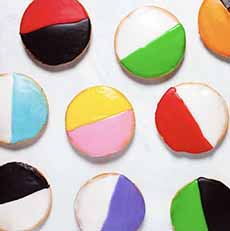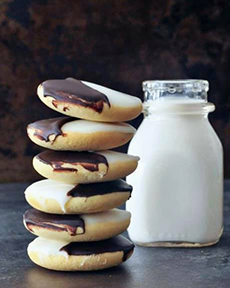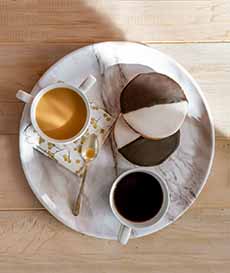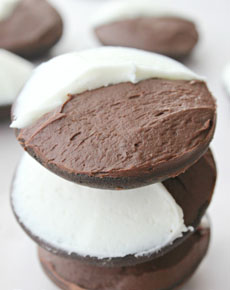Black And White Cookie History For National Black & White Cookie Day
|
|
Oh, what a great reason to eat black and white cookies: September 14th is National Black And White Cookie Day. One of our favorite cookies since childhood, these large cake-like cookies are iced, half in vanilla fondant or boiled icing, half in chocolate icing. Today, most bakers use boiled icing; it’s easier and less expensive than fondant. Because some of the cookie’s fans preferred one side of icing more than the other, some bakers make all-chocolate or all-vanilla-iced cookies in addition to the black-and-white. We call them “full moon cookies” (you heard it here first). A good black-and-white cookie is fresh, so that the yellow cake is not hard* (it dries out easily). A tip: If you’re buying them in a store where you help yourself, to place a finger on the underside and press. It should be springy. The cake is made with vanilla extract and ideally, a teeny hint of almond extract in it. The icing has just enough sugar, not too much. Pursuant to the ideal of soft cake, black-and-whites are actually neither cookie nor cake, but a hybrid. They are a drop cake†, which adds extra flour to cupcake batter so the batter can be dropped on a baking sheet without running. Like cookies, they are finger food. Unlike cookies, which are hard and can be stored at room temperature two to three weeks (2 months in the fridge, 8-12 months in the freezer), they need to be consumed within a day. > The recipe for black and white cookies is below. > Also below, the history of black and white cookies, also called half moon cookies. > The 10 basic types of cookies. > The different types of cookies, a photo glossary. > The year’s 44 cookie holidays. A black-and-white isn’t always iced with chocolate and vanilla. Sometimes colored icing is substituted for the chocolate; for example, pink and white icing for Valentine’s Day (photo #4), green and white icing for St. Patrick’s Day, blue and white icing for Chanukah. For Halloween, bakers often do white and orange, or chocolate and orange (photo #5); and similarly, with red and green for Christmas. Sometimes the colors are replaced entirely, e.g. with team colors or wedding colors (photo #6). The black-and-white cookie, a New York City favorite for generations, has an uncertain origin, but emerged in New York City in the early 1900s. The earliest printed reference we’ve found is a testimony from a third-generation baker at Glaser’s Bakery in Yorkville, a German neighborhood on the Upper East Side, who noted that the bakery had made black-and-white cookies since it opened in 1902 (source). Glaser’s black-and-whites were a dry but soft, cakey base made with buttermilk or sour cream. They were topped with fondant—chocolate on one side, vanilla on the other. Glaser’s is credited with popularizing (if not inventing) the black-and-white cookie. Is it possible that the bakery founder, a Bavarian immigrant named John Herbert Glaser, brought the idea with him from Germany? Well…in Germany, black-and-white cookies are called Amerikaner (American) cookies [source]. Or is it the other way around? According to one source, Amerikaners came to Germany from the U.S., hence the name. The cookie became especially popular in Jewish bakeries and delis throughout New York during the mid-20th century. Alas, Glaser’s Bakery, long an institution on the Upper East Side of Manhattan, closed its doors after 116 years (on July 1, 2018). The third generation baker, Herb Glaser, was ready to retire. The cookie gained national fame, especially after being featured in the 1994 “Seinfeld” episode, “The Dinner Party,” in which Jerry holds up a black-and-white cookie and says, “Look to the cookie!”, as a metaphor for racial harmony. After this moment, black-and-whites began to appear in bakeries and supermarkets across the country. The half moons look just like black-and-white. In our youth, black-and-whites were also called half moon cookies. In Upstate New York and parts of the Midwest, half moon cookies are black and white, but they usually have fluffy frosting, not smooth fondant, and a domed, more cakey base (photo #9). The first print reference we found to a half moon cookies is to Hemstrought’s Bakery in Utica, New York, which started baking half-moons around 1925. Did someone see thee black-and-white in New York City and bring the idea to Utica, some 240 miles away? Possibly? Probably? Ingredients For the Cookies Make The Cookies 1. PREHEAT the oven to 350°F (175°C). Line two baking sheets with parchment paper. 2. COMBINE the dry ingredients in a medium bowl. Whisk together the flour, baking powder, baking soda, and salt. Set aside. 3. CREAM the butter and sugar in a large bowl or the bowl of a stand mixer with a paddle attachment. Beat until the mixture is light and fluffy, about 2-3 minutes. (This step is crucial for a tender, cake-like cookie.) |
|
|
4. ADD the eggs one at a time, beating well after each addition. Mix in the vanilla and lemon extracts. 5. REDUCE the mixer speed to low. Add half of the flour mixture to the butter mixture and mix until just combined. Add the sour cream and blend, then add the remaining flour mixture and mix until no streaks of flour remain. Do not overmix or you’ll get a tough cookie (no pun intended). The dough will be thick. 6. DROP dollops of the dough onto the prepared baking sheets, using a 1/4-cup measure or a large cookie scoop. Leave at least 3-4 inches between drops as they will spread. Gently flatten the mounds of dough into thick disks (about 3 inches in diameter) with a spatula or with wet fingers. 7. BAKE one sheet at a time on the center rack for 15-18 minutes, or until the edges are lightly golden and the centers spring back when gently touched. Do not overbake. 8. LET the cookies cool on the baking sheet for a few minutes before transferring them to a wire rack to cool completely. The bottoms of the cookies will be flat and they become the top for the icing. Make The Icing 1. MAKE the vanilla icing. In a medium bowl, whisk together the sifted confectioners’ sugar, 2 tablespoons of milk, light corn syrup, and vanilla extract until smooth. The icing should be thick but spreadable. (If it’s too thick, add more milk, one teaspoon at a time. If it’s too thin, add more powdered sugar.) 2. DIVIDE the icing in half into two separate bowls. Take one of the completely cooled cookies, flip it over so the flat side is up, and use a small offset spatula or butter knife to spread a thin, smooth layer of the white icing over one half of the cookie. Place the cookie on a wire rack and repeat with the remaining cookies. Allow the white icing to set for at least 30 minutes, or until a skin forms. 3. MAKE the Chocolate Icing: To the second bowl of icing, add the cocoa powder and 1-2 tablespoons of milk. Whisk until smooth, shiny, and the same spreadable consistency as the vanilla icing. Add more milk or powdered sugar as needed to adjust the thickness. Finish Icing: Spread the chocolate icing over the un-iced half of each cookie. Allow the icing to set completely for a couple of hours before serving or storing. It’s been a bit of work, but you’re now ready to enjoy the iconic New York Black and White Cookies. *You may see the cake referred to as dry-style. This means a tight crumb, with extra flour added—not hard cake. †A drop cake is an old term for a small cake made by dropping thick batter from a spoon into hot, deep fat; or baked in the oven on a well-buttered pan. Here’s a recipe for a deep fat fried drop cake. CHECK OUT WHAT’S HAPPENING ON OUR HOME PAGE, THENIBBLE.COM.
|
||











